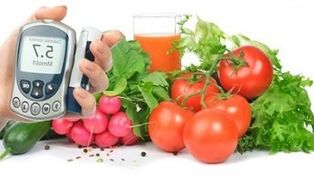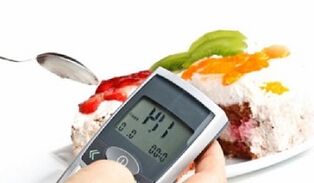
Diabetes mellitus is a disease of the endocrine system associated with a lack of insulin in the body.
As a result, the glucose content in the blood increases, which leads to metabolic disturbances and gradual damage to almost all functional systems of the human body. The disease is divided into type 1 and type 2 diabetes.
Today, nutritional and dietary problems in diabetes mellitus of any kind are an extremely serious topic that is raised by every patient after receiving a diagnosis of the disease.
In general, proper nutrition for diabetes should be followed every day, as without a diet, a person's health will deteriorate.
Tips for lowering blood sugar
Diet is essential for all types of diabetes, but dietary guidelines differ for type I and type II diabetes. In the latter case, dietary reduction of excess body weight may be the only therapeutic measure.
The type of diabetes mellitus is determined by the endocrinologist who treats you.
- In type 1 diabetes: Proper nutrition is a necessary background for insulin therapy. If you do not pay attention, all efforts to lower blood sugar will be in vain - this indicator does not stabilize, and this affects the state of the vessels of all organs and systems.
- Type 2 diabetes: does not always require drug therapy. First, the patient is recommended a diet that helps reduce weight. With good dynamics in this case, drugs may not be needed at all.
General tips for lowering blood sugar:
- Reduce your consumption of sodas, lemonades and juices. With regular consumption of sugary drinks, the risk of developing diabetes increases by about 15%. When drinking tea and coffee, reduce the amount of cream and sweeteners.
- Try to choose unsweetened foods like unsweetened iced tea, yogurt, or unsweetened oatmeal. You can sweeten your food to your liking. Most likely, you will be adding much less sugar to your food than the manufacturer.
- Replace your favorite sweets with healthier foods. Instead of ice cream, mash frozen bananas and beat the mixture with a mixer for a great dessert. Instead of your favorite milk chocolate, it's best to eat a piece of dark chocolate.
It is especially important to follow a diet for mild diabetes as it is practically the main treatment.
Differences in diet for type 1 and type 2 diabetes

For patients with type 1 diabetes mellitus, a low-calorie diet (25-30 kcal per 1 kg of body weight) is required, which prevents late complications of the disease. In this case, the diet is extremely important, it must be strictly observed. The main thing to look for when composing a diet is the balance of proteins, fats and carbohydrates.
Patients with type 2 diabetes are prescribed a sub-calorie diet (daily energy value of food 1600–1800 kcal). With such a diet, patients should lose about 300-400 g of body weight per week. In the presence of a severe overweight, the daily amount of calories is reduced according to the percentage of excess body weight to 15-17 kcal per 1 kg.
Basics of nutrition
In each individual case, the doctor prescribes a special diet for a patient with diabetes mellitus, which must be followed to keep the body in normal condition.
When you start eating right, follow these simple rules every day:
- It is necessary to take food 5-6 times in small portions (every 2-3 hours) during the day.
- The ratio of proteins, carbohydrates and fats must be balanced.
- The amount of calories received from food should equal the patient's energy consumption.
- A person should be given proper nutrition: some vegetables and fruits, cereals, dietary meat and fish, natural juices with no added sugar, dairy products, soups.
The food of a diabetic patient should be rich in vitamins, so it is useful to introduce vitamin carriers into the diet: baking yeast, brewer's yeast, rosehip decoction, SPP, food supplements.
Nutrition rules for diabetes mellitus for every day
The following foods can be consumed with diabetes:
- Bread - up to 200 grams per day, mainly black or special diabetic.
- Cooking soups on vegetable broth, it is allowed to use weak meat and fish broths 1-2 times a week.
- Meat and poultry dishes. With diabetes mellitus, it is permissible to eat boiled beef, chicken and rabbit.
- Vegetables and herbs. It is recommended to consume potatoes, beets, carrots no more than 200 grams per day. But other vegetables (cabbage, lettuce, radishes, cucumbers, zucchini, tomatoes) and vegetables (except spicy) can be eaten almost without restriction raw and boiled and occasionally baked in the oven.
- Cereals, legumes and pasta should not be eaten often. If you decide to eat a plate of spaghetti, forego bread and other carbohydrate foods and dishes that day.
- Eggs can be eaten no more than 2 pieces per day, to be added to other dishes, boiled soft-boiled or as an omelette.
- Fruits and berries of sour and sweet and sour varieties (Antonovka apples, oranges, lemons, cranberries, red currants. . . ) - up to 200-300 grams per day.
- Milk - with the permission of a doctor, kefir, yogurt (only 1-2 glasses per day), cottage cheese (50-200 grams per day) in natural form or in the form of curds, cheesecakes and puddings.
- It is recommended to consume cottage cheese every day, up to 100-200 grams per day in natural form or in the form of cottage cheese, cheesecakes, puddings, casseroles. Cottage cheese, as well as oatmeal and buckwheat porridge, bran, dog rose improve fat metabolism and normalize liver function, prevent fat changes in the liver.
- Tea with milk, weak coffee, tomato juice, fruit and berry juices (total liquid with soup up to 5 glasses per day).

Carefully plan your menu every day and use only healthy and necessary foods in your case.
Prohibited products
The diet of patients with diabetes should be thought out, first of all, people who have been diagnosed with this disease should refuse such foods:
- Sweets, chocolates, confectionery, baked goods, jams, honey, ice cream and other sweets;
- Spicy, spicy, salty and smoked snacks and dishes, lamb and pork fat;
- Pepper, mustard;
- Alcoholic beverages;
- Grapes, bananas, raisins;
- Sugar is only allowed in small quantities with the permission of a doctor.
All diabetes foods should be consumed on a schedule and to control blood glucose, the daily menu should contain fiber.
Sample menu for the day
When following a type 2 diabetes diet, you can stick to a simple menu, alternating the foods that are allowed.
Example n. 1
- Breakfast - oatmeal porridge, egg. Bread. Coffee.
- Snack - natural yoghurt with berries.
- Lunch - vegetable soup, chicken breast with salad (beetroot, onion and olive oil) and stewed cabbage. Bread. Composed.
- Afternoon snack - low fat cottage cheese. You.
- Dinner: hake cooked in sour cream, vegetable salad (cucumbers, tomatoes, herbs or any other seasonal vegetables) with vegetable oil. Bread. Cocoa.
- Second dinner (a few hours before bedtime) - natural yogurt, baked apple.
Example n. 2
- Breakfast: 150g cottage cheese, 150g buckwheat or oatmeal, black bread, unsweetened tea.
- Second breakfast: unsweetened compote 250 ml.
- Lunch: chicken broth 250 gr, boiled lean meat 75 gr, stewed cabbage - 100 gr, jelly without sugar - 100 gr, bread, mineral water 250 ml.
- Afternoon snack - apple 1 pc.
- Dinner: 150g stewed vegetables, 100g meatballs, cabbage cutlet - 200g, bread, unsweetened rosehip broth.
- Second supper: drinking yogurt - 250 ml.
Example n. 3
- Breakfast: carrot and apple salad - 100 g, low-fat cottage cheese with milk - 150 g Bread with bran - 50 g Tea without sugar - 1 glass. Second breakfast: mineral water - 1 glass, apple.
- Lunch: vegetable soup with soy - 200 g, meat goulash - 150 g, vegetable caviar - 50 g. Rye bread - 50 g. Tea with xylitol - 1 glass.
- Afternoon snack: fruit salad - 100 g Tea without sugar - 1 glass.
- Dinner: fish schnitzel - 150 g, millet milk porridge - 150 g Bread with bran - 50 g Tea without sugar - 1 glass. Second dinner: kefir - 1 glass.
Remember:a person with diabetes should not be hungry. You should eat at the same time, but if a slight hunger occurs between main meals, you should definitely muffle it with a cup of tea or vegetables. But it should only be a light snack - overeating is dangerous for a diabetic.
































